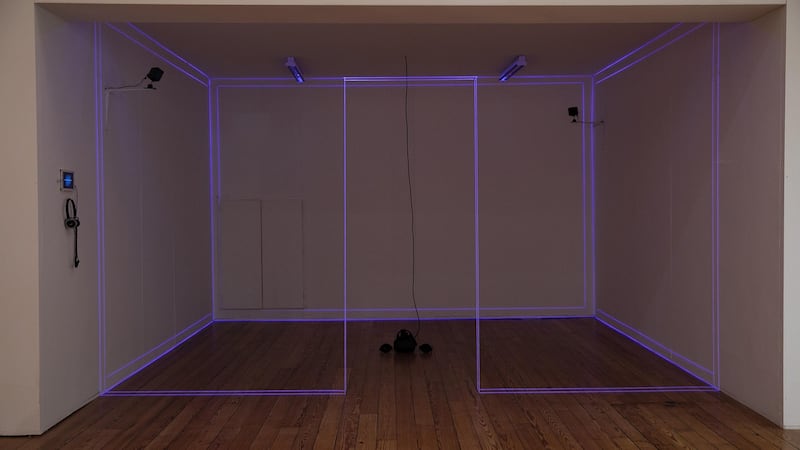There is something heartbreaking about the annual routine of fine art degree and MA shows. Each graduate puts together what is really a solo exhibition, usually investing heroic levels of effort and expense, and then it’s all over, generally after just one week. Definitely with a whimper, not a bang.
It’s true that some curators make a point of seeing as many of the shows as they can. And there have, over the years, been worthwhile efforts to give another lease of exhibition life to a tiny proportion of the work – by Lismore Castle Arts, for example, plus other initiatives.
In recent years the RDS has been active in reformulating its Visual Arts Awards and last year came up with a good formula, one that’s ambitiously heavy on logistics. That is, have a curatorial panel see the grad shows and come up with a longlist of artists which, after a bitter and acrimonious debate – sorry, make that after carefully reasoned discussions – is whittled down to a manageable number for exhibition. The award winners are then selected from that shortlist show.
An important point is that an artist – last year Alice Maher, this year Nick Miller – is invited to put a form on the show, which has proved to be a very positive development.
As an institution, the RDS has a venerable (since 1731) record in Irish cultural and scientific life, thriving in an era of pedagogical and social idealism in the teeth of political gales, planting the seeds of several major other national institutions including the National Library, Museum and NCAD.
Latterly, of course, there is an unbreakable, Pavlovian connection between the name RDS and the words Horse Show, an identification of the institution with the event that, important as it is, narrowed its profile considerably. One could, at a pinch, add the Craft Fair. But the other, one-time strings to its bow, art and science, clearly still matter in some way.
This year, the six-strong curatorial panel visited degree and MA shows in 12 colleges and long-listed 122 artists to apply for the awards, of which there are several. Prime among them is the prestigious Taylor Art Award, worth €10,000.
This year it went to Kevin O'Kelly, an exceptionally capable NCAD graduate whose Something About the Way You Look situates the visitor – one at a time – in a small, domestic interior, but one that offers a prospect of a distant window into another domestic space, occupied by another individual, who initiates an interaction. At first ominous, it becomes a meditation on anomie, isolation and the nature of communication in a world of strangers.
However, Elaine Hoey, last year’s Taylor winner, this year an MFA contender, achieved the distinction of taking both of the other two main awards, the €5,000 RC Lewis Crosby Award and the new Mason Hayes and Curran-sponsored award of a three-month residency in the Centre Culturel Irlandais in Paris, also valued at €5,000.

Hoey works with virtual reality, and her Fiction is Fact pitches the visitor into an engagement with four distinct narrative settings in which "fiction is the new reality".
Hoey and O'Kelly were two of a shortlist of 13 artists, and a careful look at the exhibition confirmed that there were several other strong contenders, any of whom would equally have been worthy winners: a good indication of the overall standard of the selection. Among the stand-outs was Kevin Smith who, it's fair to say, was the smash hit of this year's DIT Creative Arts show. His film Love in Technicolour incorporates elements of performance art and cinematic narrative in probing the construction and enactment of masculinity in society. It has a raw, visceral energy, enhanced by an integral spoken soundtrack delivered with poetry slam gusto.
Ara Devine's film, The Irish Question, is in its way another gem. Surprisingly so, because it sounds overly schematic in outline: a compilation of archive footage explores aspects of stereotypical mid-20th century Irishness, with subtitled Irish language narration, and a second sequence consists of video and photographs by asylum seekers stuck in the purgatory of direct provision, with subtitled Arabic narration. It's an immensely thoughtful, tactful piece of work that quietly asks questions about identity. Like Smith's film, it deserves widespread circulation.

Ann Ensor’s skeletal steam-bent oak sculpture, based on the shell of the pearl mussel on a larger than human scale, echoes the protective, enclosing function of its source while broadening its symbolic implications. The ribcage-like form evokes both the tiny mussels and the living, breathing planet and organism and organic communities in between. It’s augmented by an environmental recording from mussel beds in Co Kerry.
The self-contained poise of Eve O’Callaghan’s large-scale abstract paintings may have told against her in an issue-hungry curatorial era. They stood out at NCAD and they still do. It’s worth pointing out that she takes on an idiom that is generally the preserve of assertive male artists and excels at it.
Hannagh Clegg’s dark Goya-influenced allegories were atmospheric. Monika Bogyos’s wearable sculptural costumes really came to life in the projected dance piece that formed a backdrop to her installation, and there is clearly real richness in her work. While several artists – Matthew Bourree, Isabel English, Stephanie McGowan and Yasmine Robinson – had interesting core concerns, their physical expression was not yet quite there.
The show was in the RDS Concert Hall, which was effectively adapted to accommodate the differing requirements of a wide range of work. It’s not a gallery, though, and the lighting was on the harsh side. In addition, the run was absurdly brief (October 25th-30th). Presumably, as a venue, the RDS is geared to events and fairs of short duration, but the awards exhibition deserves a two-week period so that the widest potential audience can get to see it.










